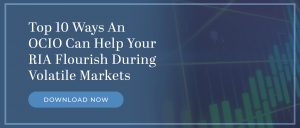Technology’s role in investment management is not a fad; it’s a fundamental shift.
It’s amazing how fast technology has evolved over the past few years, especially for the financial services industry. Consider how the integration of AI and blockchain technologies has already improved the speed of data gathering for important investment research and management decisions.
For independent RIAs and IARs, keeping pace with emerging technologies requires time, a willingness to learn, and financial resources to pay for the cost of new technology.. If you don’t have the time, inclination, or resources (people or dollars) to fund this expansion for your firm, you may want to consider partnering with an Outsourced Chief Investment Officer (OCIO), which we’ll discuss in this blog.
As an independent investment research and portfolio management firm, Cornerstone Portfolio Research recognizes that technological advances are changing the game for RIAs and IARs to compete against larger brand-name firms.
The OCIO Evolution: From Admin to Advantage
OCIOs have come a long way since their early days as a convenient solution for delegating administrative and operational duties. Over time, they have evolved to offer a more high-touch, strategic partnership, particularly in investment decision-making and portfolio supervision.
Historically, the investment officer in many institutions relied on a mix of market experience, qualitative judgment, and a few basic financial models. Today, the OCIO role has transformed—including the use of sophisticated algorithms, machine learning, and diverse and deep data sets that assist in complex decision-making processes.
Technology makes it possible to use more complex investment strategies and respond more quickly and effectively to market trends.
Leveraging Technology and Data Analytics to Identify Market Trends
OCIOs are harnessing the power of technology and advanced data analytics to identify and capitalize on market trends. Here are some tools and methods used.
Artificial Intelligence (AI) and Machine Learning (ML) in Market Analysis
OCIOs employ AI and ML algorithms to analyze market trends, predict future movements, and make data-driven investment decisions. These technologies can process vast amounts of data at high speeds, uncovering insights that might not be visible through traditional analysis.
Comprehensive Analysis Through Big Data
OCIOs use big data for macroeconomic analyses to assess the economy’s condition. They also perform microeconomic analyses to understand the fundamentals of specific companies or sectors. This holistic view supports more informed investment decisions.
OCIOs can use sophisticated ML algorithms and extensive financial data to analyze historical stock performance, current news, and economic data to help pinpoint potential market corrections or booms. These algorithms analyze large datasets to find patterns and anomalies that would normally be hard to spot.
Sentiment Analysis: Understanding Market Emotions
OCIOs can use sentiment analysis to gauge the market’s mood and anticipate shifts in investor behavior. By examining social media, news articles, and financial reports, they can better understand the collective sentiment toward certain investments or market conditions, providing additional insight for making strategic decisions.
Using advanced tools and analytics, OCIOs strive to identify emerging market trends and adjust portfolios using data-driven strategies beyond traditional analysis.
Other Ways OCIOs are Using Technology for Portfolio Management
Technology is central to how OCIOs can manage client portfolios, enhancing efficiency and effectiveness. Here’s a closer look at additional ways an OCIO may use technology to build and monitor your clients’ portfolios:
- Performance measurement: Many portfolio management platforms today offer sophisticated performance analytics. OCIOs can track portfolio performance against benchmarks, identify sources of alpha (excess return), and isolate the impact of individual investment decisions. This level of insight allows for continuous portfolio optimization and potentially improved risk-adjusted returns.
- Quantitative analysis tools: Advanced quantitative analysis tools enable OCIOs to perform sophisticated risk assessments, optimize asset allocation, and test investment strategies against historical data.
- Stress testing and scenario modeling: OCIOs can use various tools to simulate market scenarios and assess the potential impact on client portfolios. This stress testing helps identify potential risks and develop contingency plans, promoting proactive portfolio management.
- Real-time market insights: Advanced technology tools enable OCIOs to access real-time financial news, market data, and investment research. This immediacy can allow quick strategy changes based on market trends, giving them a competitive advantage.
- Automated workflows: Repetitive tasks like data collection, portfolio rebalancing, and trade execution can be automated using portfolio management software.
- Blockchain for enhanced transparency and efficiency: Blockchain is a special database that keeps information in blocks connected with cryptography, mostly used to record transactions like a ledger. There’s growing interest in its ability to improve transparency, reduce fraud, streamline operations in portfolio management, offer possibilities for secure transactions and record-keeping, and verify the authenticity of financial assets.
- Integration of ESG factors: OCIOs are leveraging technology to evaluate ESG risks and opportunities more effectively, striving to meet clients’ ethical and financial needs.
Data Quality and Integration: The ‘garbage in, garbage out’ adage holds in data analytics. Reliable data is crucial for accurate analysis. OCIOs seek to use high-quality, timely data and have governance policies to manage it. Additionally, data integration platforms combine financial, market, and client data from various sources, creating a unified view for insightful decision-making.
Cybersecurity and Data Privacy: With great technological power comes great responsibility, especially when handling sensitive financial data. OCIOs prioritize cybersecurity and data privacy, implementing advanced security protocols and regularly updating their systems to protect against threats.
Compliance and Regulatory Technology (RegTech): Regulatory requirements and investor expectations around transparency and compliance have never been higher. With advanced analytics tools, OCIOs strive to align portfolios with investment guidelines and regulatory standards. RegTech helps with adherence to regulatory requirements and standards, streamlining reporting and compliance processes through automation.
Embrace the Future with Cornerstone
The future brings with it unknown challenges and opportunities, but one thing is clear: RIAs and IARs who embrace current technology to make informed investment decisions will be better prepared than those who don’t.
As you can see from the above descriptions technology can provide investment professionals with a plethora of data, but then the question is do you have the time, knowledge, and resources to implement these processes internally?
At Cornerstone Portfolio Research, our approach is not just about adapting to change but about anticipating and shaping the future of investment management. Drawing on decades of experience in the financial services industry, we help independent financial advisors outsource their investment management and research.
Discover how a strategic partnership with Cornerstone can transform your investment approach and leverage innovation to your advantage.
Please feel free to connect with us for an introductory call.


